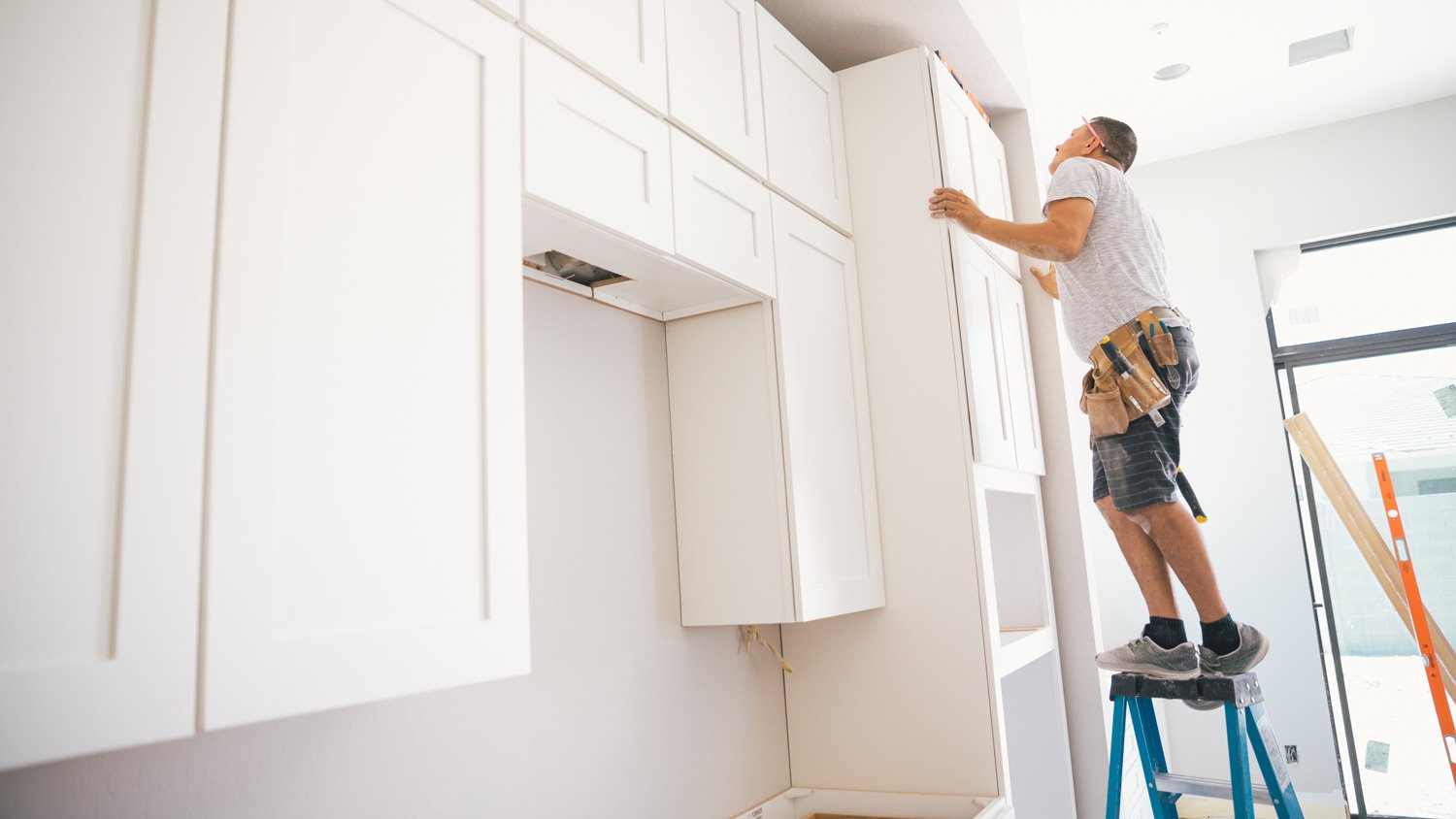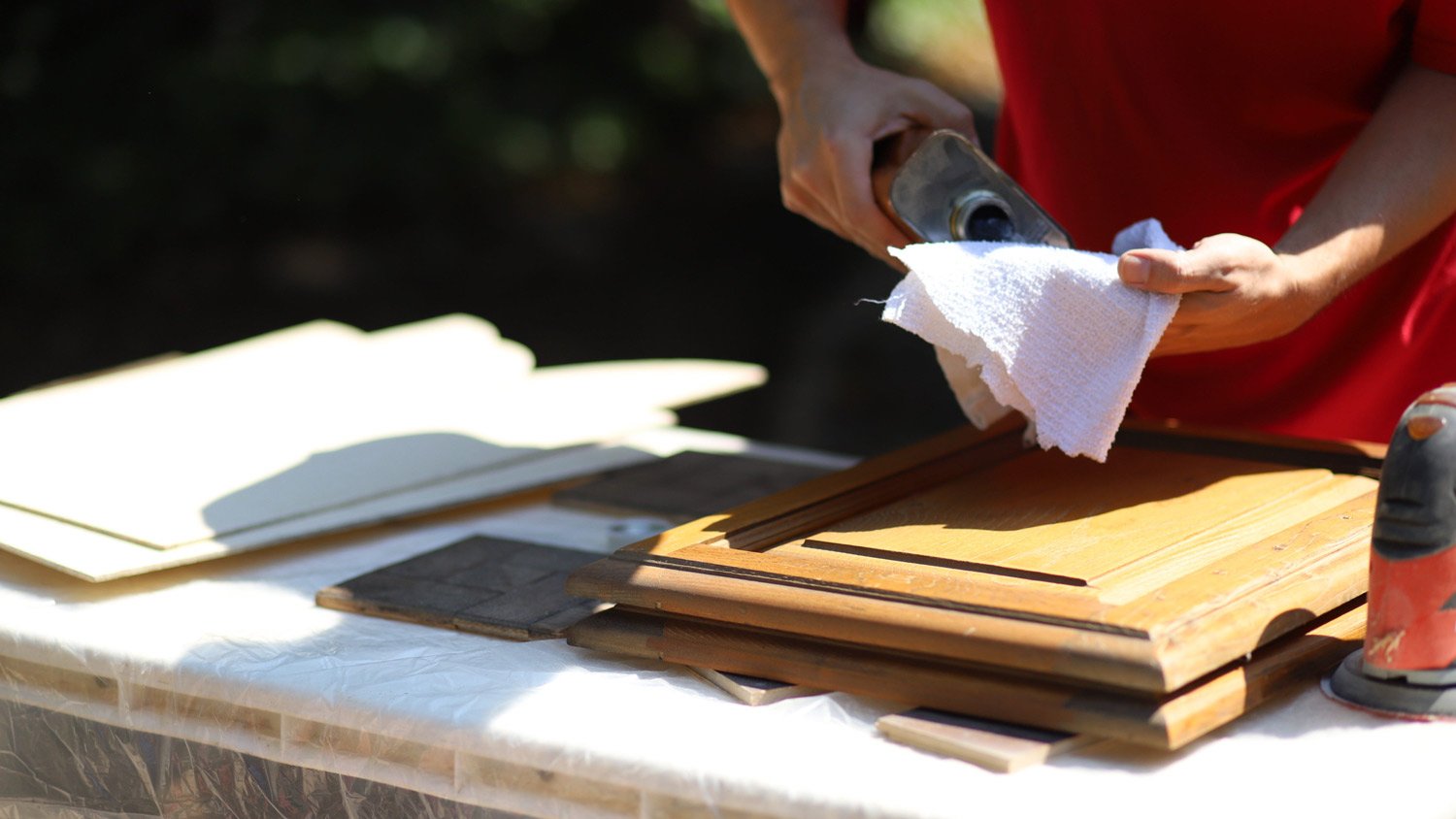Cabinet Refacing vs. Refinishing: Key Differences
If your cabinets need an upgrade, consider whether you should reface or refinish them based on the type you have in your home


Have your cabinets seen better days? If so, it may be time to change them up. When you think about cabinet refacing vs. refinishing, the first few things that come to mind are time, energy, and expense. Here are a few ways to decide which approach is best for your cabinet refresh and how to budget for the project.
Quick refresher: Refacing cabinets involves removing, replacing, and reattaching the doors. On the other hand, cabinet refinishing requires sanding down the existing doors and revitalizing them with new paint, stain, or lacquer.
Cabinet Refacing vs. Refinishing

While cabinet refacing involves replacing the doors and drawer fronts with new materials, refinishing updates the existing doors and drawers through projects like repainting or restaining. An easy way to differentiate between these two types of cabinetry projects is that refacing is a renovation for your cabinets, while refinishing is a spruce or an upgrade.
What Is the Difference Between Refinishing, Refacing, and Resurfacing Kitchen Cabinets?
Although the terms are similar, these cabinet upgrades vary in cost, labor, and final results.
Refinishing
Refinishing is a laborious project involving stripping off the cabinets' existing paint or stain. It starts with sanding the surface, sometimes involving a chemical paint or stain remover. This can be a cost-effective DIY project if your cabinetry is in good structural condition. However, inexperienced do-it-yourselfers may want to leave this project to the pros because achieving a smooth and flawless finish is challenging.
Resurfacing
Resurfacing requires expert measuring skills and the appropriate tools to replace the outer layer of your cabinetry with brand-new veneers. The process involves cutting and applying wood or laminate veneers to cabinet and drawer fronts for a brand-new look and is more costly than refinishing. A local cabinet repair specialist can help determine the best solution for your budget.
Refacing
If you want to reinvent your cabinets completely without replacing them, refacing is the way to go. Refacing means replacing your existing cabinet doors, drawer fronts, and hardware while keeping your cabinet boxes. While this solution is more affordable than installing all-new cabinetry, it is more expensive than refinishing and resurfacing.
When Should I Consider Replacing or Repairing My Cabinets?

If your cabinets are damaged or have cosmetic imperfections like scratches, holes, fading stains, or chipping paint, you may want to consider upgrading. If the cabinet doors are truly damaged beyond repair, refacing them may be your only option. However, if you’d like to save on the cost of buying new cabinet doors, refinishing is a DIY project most homeowners can handle on their own for the most part.
The reality is that if refinishing is the right solution for you, it could be a money-saving endeavor compared to refacing. There are quite a few considerations.
Reasons to Refinish Cabinets

The look and style of your cabinets have a big impact on your home. Take a look at the reasons to refinish your cabinets instead of refacing them to decide what’s best for you.
Cost
Refinishing cabinets is generally more affordable than refacing, however, refacing is about 30% to 50% of the cost of replacing the cabinets entirely. Refinishing cabinets costs about $1,500 to $5,000. For example, staining cabinets costs around $4 to $10 per square foot on average (including labor and materials), while the cost to reface cabinets runs between $4,300 and $9,980 for the whole project or $90 to $450 per linear square foot depending on the material.
You Like Your Existing Cabinet Doors
Refinishing could also be the right option if you like the cabinet doors you have now. The finish you are looking for is an important consideration. If you want to go from stained wood to a darker stained wood or to a solid color, this could be the way to go. However, you typically can’t go from a solid color to a stain.
You Want a Custom Look
When you refinish your cabinet doors versus reface, you can fully customize the look you want with paint, patterns, and finishes.
Your Existing Cabinets Have Minimal Issues
Why replace them if your existing cabinets have minimal issues? Refinishing them instead can hide minor wear and tear and imperfections while saving you money.
Reasons to Reface Cabinets
Updating your cabinets can be a major project, and a costly one too, no matter which way you decide to go. These are a few of the top reasons homeowners typically decide to reface their cabinets instead of refinishing them.
Long-Lasting
Brand new cabinet doors will likely last up to 50 years, meaning you’ll have them much longer than your old doors if you refinish them.
Existing Finish Is Coming Off
Finally, if your existing finish is starting to come off, such as splitting Rigid ThermoFoil (RTF), you are not a candidate for refinishing. You could have the doors or drawers that are splitting replaced and then refinished, but what if more of them start splitting after you spend a good bit of money on a refinishing job?
The point is that if you don't have a good substrate to refinish, you are a much better candidate for refacing.
Your Cabinets Are the Wrong Material for Refinishing
The material under the solid color cabinets usually is not stainable. Cabinet makers don't buy expensive stain grade wood only to cover it up with an opaque color. Typically, white cabinet doors are milled out of medium-density fiberboard (MDF), which cannot be stained to look like wood because it is not real wood.
Even if the doors on solid color cabinets are real wood, they are likely paint grade, which means they still wouldn't look good with stain, even if it were feasible to strip them to bare wood.
Oak cabinets are very poor candidates for refinishing. If you refinish them in a solid color, the grain will show right through the paint (lacquer or any other type). If a refinisher tells you otherwise, give them one of your doors or make them get a sample oak door and finish half of it to show you they really can hide the grain.
You Want to Update Your Cabinet Door Hinges
If you have old visible butterfly hinges and want modern hidden hinges, you’ll want to reface. This leaves the screw holes and impressions left by the old hinges to contend with, so refinishing won’t look as nice. However, If you are going to a solid color, butterfly hinges aren’t so much of an issue, as you can fill the screw holes. You can either refinish or reface if this is the case. Important Consideration for Refinishing Cabinets
Before you refinish your cabinets, you need to know what to put on them and what to expect, especially if you’re hiring a local cabinet contractor.
Lacquer
First off, the finish that will give the best service in the kitchen is lacquer. To do a good refinishing job, you have to be willing to have a crew come in and spray finish your cabinet boxes in your kitchen.
This will take three to four days to accomplish, including a day to set up and mask everything off. It’s good to plan to go out of town while they are doing the work because solvent-borne lacquer gives off a lot of volatile fumes during application, which can remain in the air for a day or more.
Frequently Asked Questions
The most significant downside of cabinet refacing is that it's cosmetic and will not fix structural issues with your existing cabinetry. If your cabinet boxes are warped or damaged, refacing will not boost their functionality.
Cabinet refacing can last up to 20 years or more with proper care and reasonable daily wear and tear. High-quality materials also play a role, possibly boosting the lifespan to 50-plus years.
The cost of cabinet refacing depends mostly on the materials you use, your kitchen's size, and the amount of cabinetry you have. On average, homeowners can expect to spend between $4,235 and $10,230 on a refacing project, though high-end materials or custom upgrades can push costs even higher.





- Should I Paint or Refinish My Kitchen Cabinets?
- 5 Common Problems With Refacing Kitchen Cabinets
- How To Build Cabinets: 9 Steps to Follow
- The Pros and Cons of Painting Kitchen Cabinets
- 10 Updates to Make Your Kitchen Cabinets Look New Again
- How to Paint Kitchen Cabinets: A Complete Guide
- Should You Paint Your Cabinets White? Here Are the Pros and Cons.
- How to Clean Kitchen Cabinets With Ease
- 5 Tips for Choosing the Best Kitchen Cabinets
- How To Install Kitchen Cabinets: 10 Steps to Success











